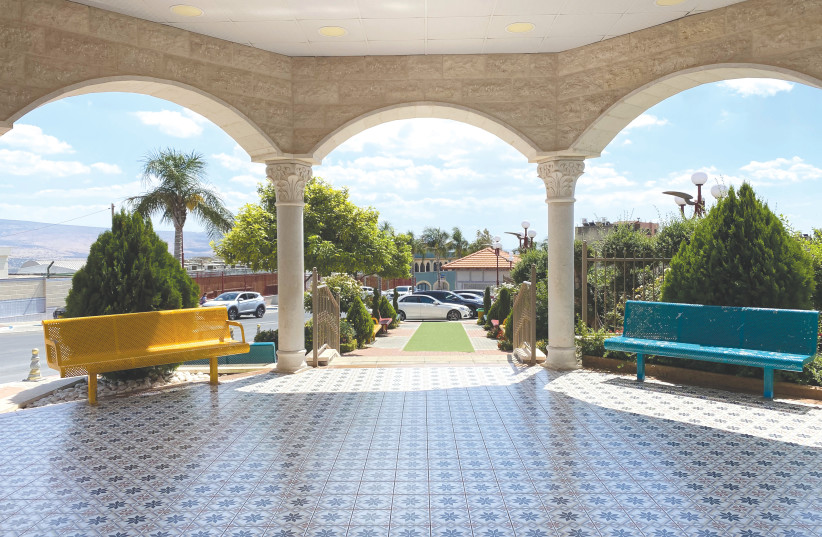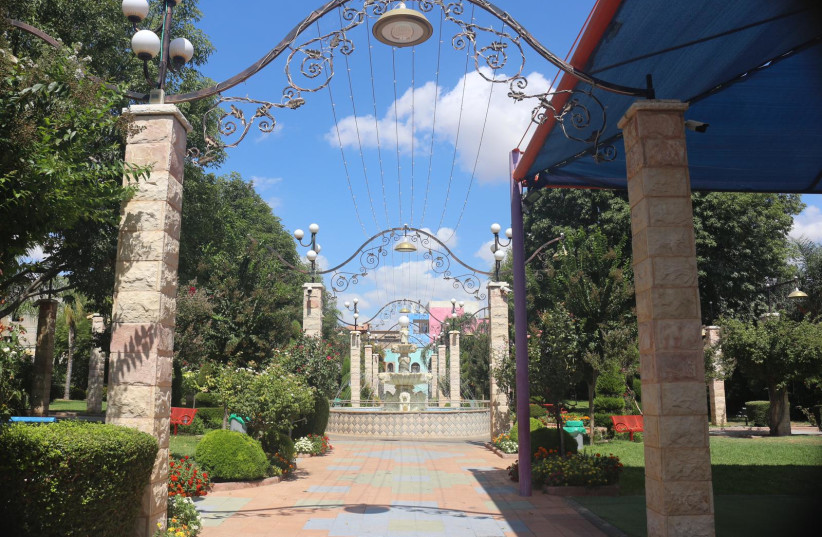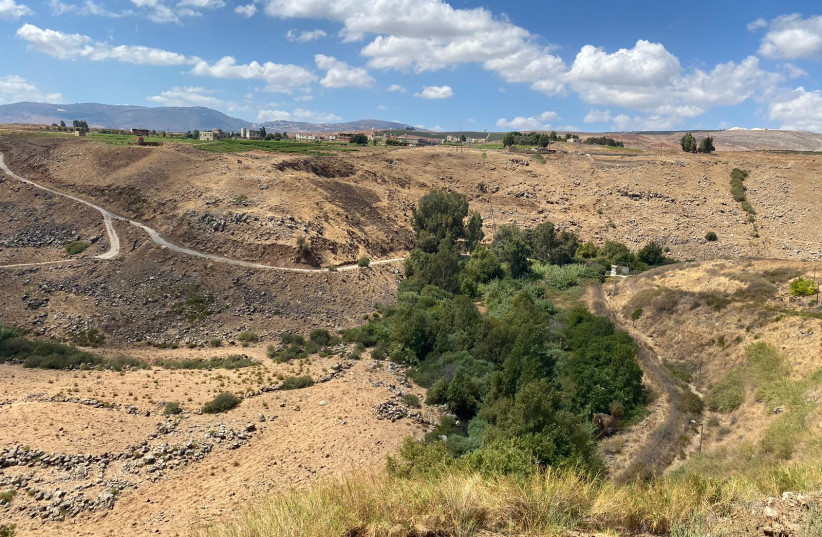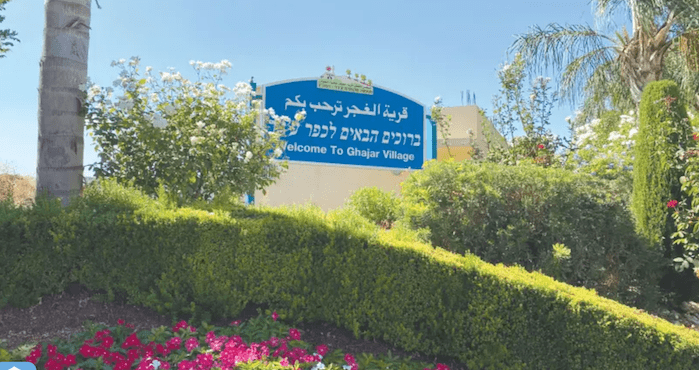https://www.instagram.com/tv/Cjr9FrIsZ73/?igshid=MDJmNzVkMjY%3D
NORTHERN AFFAIRS: Ghajar has long been a closed military zone, but 22 years later, Israel suddenly opened it for tourists.
The drive to Ghajar is long, winding and stunning. The narrow agricultural roads through the Hula Valley make you slow down and appreciate the view of the Golan mountains.
A left turn off of Highway 99 is a narrow, unmarked road that has tall concrete blocks halfway through. But a few moments later appears a stunning fountain, welcoming drivers to the only Alawite town in Israel, a town with a long and complicated history.
Ghajar has long been a closed military zone and off-limits to tourists, with only residents of the town astride the border between Lebanon and the Israeli Golan allowed in. But 22 years after Israel’s withdrawal from southern Lebanon, the IDF quietly dropped requirements for special permission to enter – with no reason given.
The history of Ghajar
Originally a Syrian village, Ghajar was captured by Israel when it conquered the Golan Heights during the Six Day War in 1967. But, convinced that the town was part of Lebanon, the troops withdrew.

While half of the town fled into Syria following the Israeli invasion, for four weeks after the subsequent retreat of the troops, leaders in the town petitioned Israeli authorities to include Ghajar in Israel, as they opposed dividing the town and preferred to remain under Israeli rule.
On July 10, 1967, Ghajar officially became part of Israel and, in 1981 all residents received Israeli citizenship, making them the only people in the world to hold dual Israeli-Lebanese citizenship (despite the two countries being officially at war with each other).
When Israel unilaterally withdrew from its security zone in southern Lebanon in May 2000, the international border was set by the United Nations. But it split the town in two, with the southern half under Israeli control, and the northern part in Lebanon.

“We learned about the withdrawal from the news. We were surprised by the UN and IDF forces putting a border in the middle of our village,” Najib Khateb, a resident of the town, told The Jerusalem Post during a recent visit organized by the ALMA Research and Education Center.
“For three months we didn’t know who we belonged to. But the worst is to be a refugee; we would rather die here on our land than become refugees,” Khateb, whose family can trace its roots in the village hundreds of years back, said.
Israel nonetheless maintained de facto control over the entire town, and the situation remained unchanged for years. The IDF set up a checkpoint at the sole road to enter the town from the Israeli side. Those who wanted to enter the town had to receive special permission from the Israeli military and had to leave by 10 p.m.

“The hardest part was to live in a place that was like a prison,” Khateb said, explaining that residents had to get permission from the military for the most basic things. “For a friend to come visit, a family member, a technician… everything needed permission from the army.”
Ghajar, he said, became a sort of independent state, with a virtual border between north and south.
A town in Hezbollah’s sights
There are some 2,500 residents of Ghajar, and despite the fact that the town is half in Lebanon, residents identify as Syrian. Despite Ghajar being originally Syrian, it’s always in the sights of Hezbollah.
IN NOVEMBER 2005, just eight months before the outbreak of the Second Lebanon War, Hezbollah tried to abduct IDF troops deployed to the town.
Dozens of fighters from the group’s special forces, some riding ATVs, infiltrated into Ghajar, as other Hezbollah terrorists began shelling Israeli positions on Mount Dov, also known as Shaba Farms, an area of some 160 sq.km. which is held by Israel but which Hezbollah disputes as belonging to Lebanon.
The gunmen directed mortar and rocket fire at IDF positions and struck and damaged military equipment, as well as a civilian home in Metulla, to distract the IDF from the kidnapping operation in Ghajar.
The kidnapping attempt was thwarted by quick thinking paratroopers who had been patrolling near Ghajar. The company commander evacuated the troops from their post and ambushed the terrorists in a nearby building, killing three of them and forcing the rest to retreat. No IDF troops were harmed.
The incident, which lasted several hours, was the most sustained round of fighting between the two sides for months until the Second Lebanon War broke out. The incident came after IDF forces were on alert for possible kidnapping attempts in the Shaba Farms area by Hezbollah.
Israel and Hezbollah fought a deadly 34-day war in 2006, which came to an end under UN Security Council Resolution 1701. The resolution called for disarmament of Hezbollah, withdrawal of the Israeli army from Lebanon, deployment of the Lebanese army and an enlarged UN force in the south.
Nevertheless, in the years since the devastating 34-day war, Hezbollah, with the help of Iran, has increased its arsenal with 150,000 rockets and missiles aimed at the Israeli home front, along with attack drones and other advanced weaponry.
The military believes that while the border with Lebanon is quiet, there’s always the potential for escalation on the border.
Khateb told the Post that while not every home has a bomb shelter, and while the IDF’s Northern Shield project to build shelters in northern communities does not include Ghajar, the residents of the town “are not afraid.”
“We are not political; it doesn’t interest us. We feel safe, and we just want to live with respect,” he said, explaining that residents do not serve in the IDF but, rather, volunteer for other forms of National Service, such as serving in the police, Fire and Rescue Services or Magen David Adom.
Ghajar has nevertheless seen many smuggling attempts, which the military believes provide Hezbollah with intelligence on troop deployment and response time.
A senior defense official told the Post in a recent interview that there is nothing that happens in south Lebanon without Hezbollah’s knowledge.
“Those who cross are interrogated by Hezbollah. They ask them how long did it take them to cross, how long did it take [IDF] troops to apprehend them, etc.”
During the Post’s visit to Ghajar, a Lebanese army patrol and UN forces were easily seen on the Lebanese side of the Snir Stream near the village of Arab Louaize. A white UN tower was on the valley floor, marking the border between the two enemy countries.
According to the senior defense official, UNIFIL forces are unable to do anything, due to Hezbollah operatives in south Lebanon.
“UNIFIL can’t move around south Lebanon freely; they need coordination with the [Lebanese Armed Forces], which comes only two or three hours later. In the meantime, Hezbollah moves its weaponry from the spot where UNIFIL wants to inspect,” he said. “And the same goes with private lands; [UNIFIL] can’t go there.
“Hezbollah is in charge of south Lebanon,” he said. “We see tens of hundreds of Hezbollah operatives along the border. One out of every four buildings is used by Hezbollah to store weapons, [serve as]command centers and to observe IDF troops.”
AFTER WE left the lookout over the Snir Stream, Khateb brought us to the Bisan restaurant, where we sat down to possibly one of the better meals in northern Israel, except that, officially, the restaurant is on the Lebanese side of Ghajar.
“Lunching in Lebanon,” quipped one of the ALMA researchers, as we checked our maps to see where we sat.
When we walked in, there was only one other local family inside. But shortly after we sat down, two Israeli tourists walked in, and were eagerly greeted by the owner, who had just brought us a dozen various salads along with the town’s local shanklish – a dried cheese with an aromatic flavor and unique taste.
After the round of salads, of which we of course asked for seconds, came a large platter of meat on a lazy Susan – chicken, lamb chops, merguez and, of course, mejadra. We finished the meal with a strong cup of Arabic coffee.
We arrived at the restaurant after we strolled through the Peace Garden, which has a beautiful fountain and a well-kept park, where kids were busy playing. Next to the park is a dazzling building that serves as a community shelter and bomb shelter.
According to Khateb, the municipality receives funds from the state and decides what to do with them. The funds were obviously put to good use, with the streets cleaner than any in central Israel, such as Tel Aviv, Rishon Lezion or Jerusalem.
The self-rule that the village enjoys allowed them to invest heavily in the education of their children. Ghajar, Khateb said, has one of the highest matriculation levels in the country.
The majority of the residents work as doctors, lawyers, professors and dentists.
Until the outbreak of the Syrian civil war, the residents, like Israel’s Druze, were able to obtain higher education in Syria, and many went there to study medicine, mostly in Damascus, before coming back to work in Israeli hospitals.
One student from Ghajar, Khatib Jabbar, was stuck in Syria for seven years after the war broke out, while he was studying medicine in Damascus. Following the outbreak of the civil war, the Quneitra border crossing was closed, forcing many students to make their way back to Israel via Jordan. But Jabbar and another Druze student, Nadine Beriq from Majdal Shams, were stuck, unable to get home.
But following pressure from the International Red Cross, their families and the Druze spiritual leader in Israel, Sheikh Mowaffak Tarif, Defense Minister Benny Gantz authorized a humanitarian request to let them return via the closed Quneitra crossing.
Unlike the Druze, who keep close ties with their families in Syria, Ghajar residents are not in touch with their families who fled in the 1960s, Khateb said.
The geopolitical complexities of Ghajar, which have helped preserve traditions for decades and allowed a community to flourish, have made it one of the most intriguing places in the country.
Though there are no hotels, Airbnb properties or local bed-and-breakfasts, it’s only a matter of time. Ghajar is a gem just waiting to be explored.

